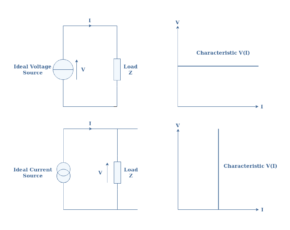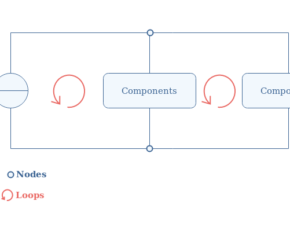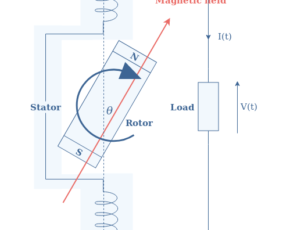Electrical Units of Measure
- Boris Poupet
- bpoupet@hotmail.fr
- 10 min
- 15.331 Views
- 2 Comments
Introduction
This article will present the different physical quantities that can be encountered in the electrical domain.
First of all, we present the most common electrical quantities by giving a table that summarizes all the different parameters associated with their unit, symbol, and measuring device. Moreover, we propose a large range of multiples and submultiples to use in order to simplify the writing.
In the second section, we present the International System of Units which is important to understand some specificities that apply to the electrical quantities. We focus on how the system is built around the defining constants and base units.
In the third section, we will focus on the electrical current, which is the base physical quantity used to describe all the other electrical quantities.
Electrical quantities
The following Table 1 presents the most important electrical quantities:

These quantities can vary on a large range of values, especially the current, resistance, and capacitance. For this reason, it is important to associate multiples and submultiples to them.
The following Table 2 gives a large range of submultiples and multiples, detailing their names, symbols, and values:

The International System of Units
SI Defining Constants
SI is the French abbreviation that stands for the International System of Units, it is the modern scientific metric system of measurement. This system is based on the defining constants which are fundamental properties of matter.
There are seven SI Defining Constants:
- The hyperfine transition frequency of Cs
- The speed of light
- The Planck constant
- The elementary charge
- The Boltzmann constant
- The Avogadro constant
- The luminous efficacy of 540 THz radiation
SI Base Units
For each fundamental constant presented previously, a SI Base Unit is associated with:
- The second (s) represents the time
- The meter (m) represents the length
- The kilogram (kg) represents the mass
- The Ampere (A) represents the electric current
- The Kelvin (K) represents the temperature
- The mole (mol) represents the amount of substance
- The candela (cd) represents the luminous intensity
SI Derived Units
The SI Derived Units are constructed around the SI Base Units, a great number of derived units exist and for this reason, but we will not list all of them.
There are however 22 named derived units such as the Newton (N), Pascal (Pa), or the ones presented previously in Table 1 such as the Volt (V) and Power (P).
Any derived units are a combination of base units, we present this link in Table 3 for the relevant derived units of this tutorial:
Application to electricity
The Defining Constant: Elementary charge
The defining constant that is relevant in this article is the elementary charge whose numerical value is e=1.602176634×10−19 C (or A*s). This value corresponds to the smallest amount of charge that can be found in nature: a proton is positively charged +e and an electron is negatively charged -e.
The electric charge is an intrinsic property of elementary particles that such as the mass is easy to experience but hard to define properly. Charges of opposite signs attract each other, which explains why electrons keep orbiting around nuclei, while charges of the same sign repel each other, similarly to magnets.
The Base Unit: Ampere
The base unit Ampere represents the transport of an amount of electric charge per unit of time across a certain material section. The SI definition of the Ampere is “a current of one ampere is one coulomb of charge going past a given point per second”.
This transport of charges is precisely what is commonly known as the electric current. We can note that due to the small value of the elementary charge, even a small current corresponds to a very large number of charges transported. As an example, a current of 1 mA approximately corresponds to the transport of the astonishing number of 6.2×1015 charges per second.
The Derived Units in electricity
It is important to note that every quantity presented in Table 1, except for the frequency and period, is derived from the current as we pinpointed in Table 3. The Ampere unit is indeed a fundamental unit derived from the definition of the elementary charge.
The Volt is defined as the potential difference that results in power dissipation of 1 W across a resistor of 1 Ω in when an electric current of 1 A is observed. From this description, the definitions of both the Ohm and the Watt can be given by rephrasing the previous sentence.
The Farad is defined as an increase of charge of 1 C in a conductor when 6,241 × 1018 electrons are added to it. It is the derived unit for the capacity which represents the ability of a conductor to store charges when submitted to a potential difference.
The Henry is the derived unit for the inductance, it is defined as the production of a potential difference of 1 V when a circuit/component is submitted to a variable electric current of 1 A/s.
Conclusion
This short tutorial has focused on the most important units to measure electricity-related parameters. First of all, we gave a table that presents the most common and important electrical quantities with their associated unit, symbols and measure devices.
In the second section, we have focused on the International System of Units which gives us the basis to understand the distinction between units and quantities. We also highlight the fact that the Ampere, which is the SI unit for the electric current, is a base unit and is used to express any other electrical unit, which are called derived units.
Finally, the last section defines in detail the elementary charge defining constant, the ampere base unit, and some derived units for the electricity domain such as the volt, ohm, watt, farad, and henry.









Yo the Coulomb’s base SI units are formatted as A.s instead of A*s in the table.
thanks for pointing us to this. We fixed it above.